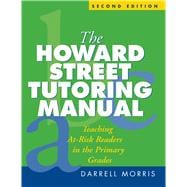This indispensable manual provides a comprehensive guide to one-on-one instruction for struggling readers in grades 1 to 3. The book addresses the "hows," "whats," and "whys" of setting up a volunteer or professional tutoring program, supplies assessment guidelines and reproducible forms, and presents in-depth case studies that demonstrate the nuts and bolts of tutoring three children at different stages of early literacy over an entire school year. Case study chapters offer clear descriptions of lesson plans, instructional activities, and informal assessment procedures, illustrated with realistic examples of student work.








